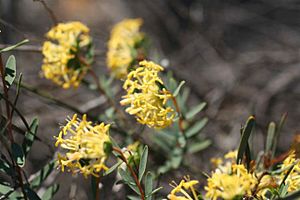Narrow-leaved pimelea facts for kids
Quick facts for kids Narrow-leaved pimelea |
|
|---|---|
 |
|
| Pimelea angustifolia in Kalbarri National Park | |
| Scientific classification | |
| Genus: |
Pimelea
|
| Species: |
angustifolia
|
| Synonyms | |
|
Synonyms
Banksia angustifolia (R.Br.) Kuntze
Banksia nervosa (Meisn.) Kuntze Calyptrostegia angustifolia (R.Br.) C.A.Mey. Calyptrostegia nervosa (Meisn.) Walp. Pimelea angustifolia R.Br. var. angustifolia Pimelea angustifolia var. calvescens Meisn. Pimelea angustifolia var. drummondi Meisn. Pimelea angustifolia var. major Meisn. Pimelea angustifolia var. minor Meisn. Pimelea nervosa Meisn. Pimelea tenuis M.B.Scott Pimelea tenuis var. longistyla M.B.Scott Pimelea tenuis M.B.Scott var. tenuis |
|
The Pimelea angustifolia, also known as the narrow-leaved pimelea, is a small shrub with pretty flowers. These flowers can be white, cream, yellow, or even pink. This plant is special because it only grows in Western Australia. When a plant or animal is found only in one specific area, it's called endemic.
What Does It Look Like?
The narrow-leaved pimelea is a small plant, usually growing between 0.1 and 1 meter (about 4 inches to 3 feet) tall. It has smooth stems. Its leaves grow in pairs, one across from the other. The leaves are often long and thin, or shaped like a narrow oval. They are smooth and a nice mid-green color. Each leaf is about 2 to 30 millimeters long and 1 to 5 millimeters wide.
How It Got Its Name
Scientists gave this plant its official name, Pimelea angustifolia, in 1810. A famous botanist named Robert Brown was the first to describe it in his book. The second part of its name, angustifolia, comes from Latin words. Angustus means 'narrow', and -folius means 'leaved'. So, angustifolia simply means 'narrow-leaved', which describes its leaves perfectly!
Where Does It Grow?
The narrow-leaved pimelea is a common plant found in many places across Western Australia. You can find it from the coast near Kalbarri all the way to the border with South Australia. It also grows inland, north of Kalgoorlie. This plant likes sandy soil, sandy clay, or rocky areas. It can be found in sand dunes, flat plains, and on ridges. Sometimes, it even grows in slightly wetter spots.
Is It Safe?
Good news! This plant is not currently in danger of disappearing.

